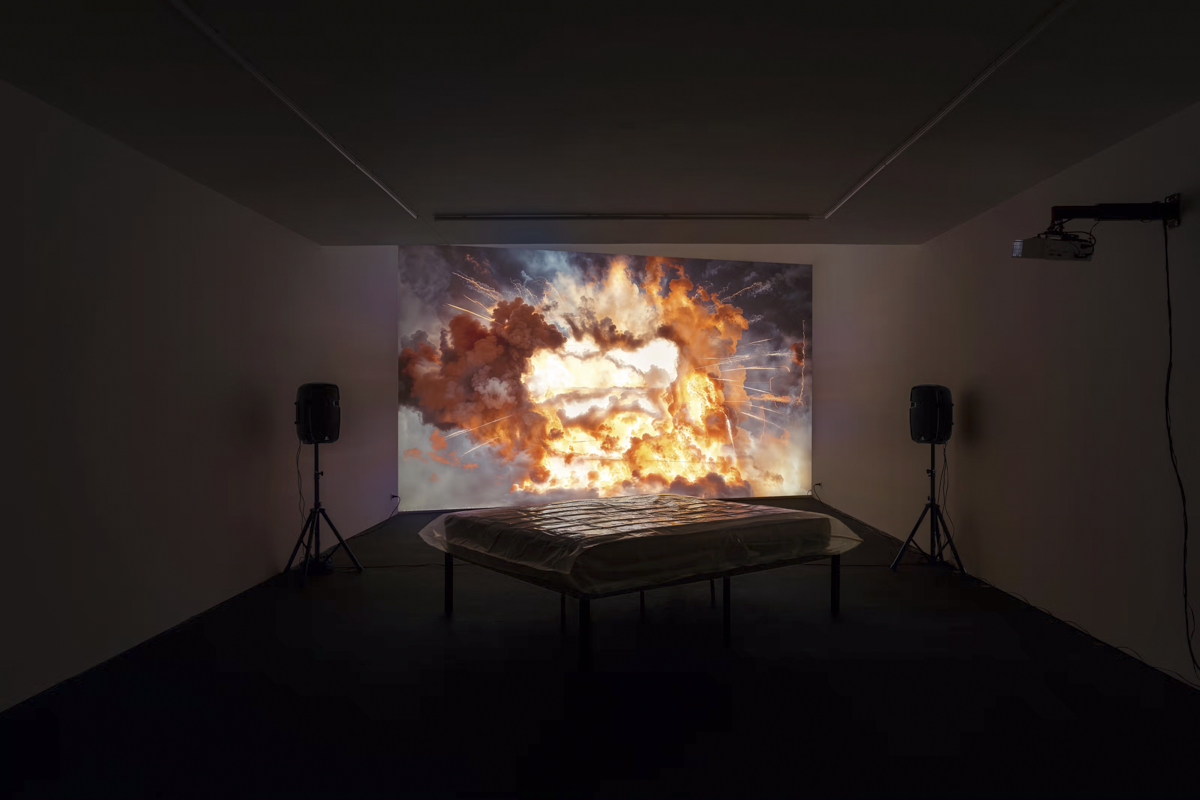IMPACT
IMPACT
SUPER DAKOTA
Brussels, Belgium
7 March 24
Press Release
For his first solo exhibition at Super Dakota, Tabor Robak undertakes an introspective exploration into the process of creation and the commodification of labor within an ultra-accelerated capitalist system. The exhibition, titled “IMPACT” unveils prevalent repression in American work and home life, exploring cultural issues within the context of technological progress and capitalist exploitation. The show is a dark comedy, split across two distinct yet interconnected thematic spaces: the office and the home.
In the main room of the gallery is a shattered cityscape of glass office furniture with 26 unique videos that incorporate animated imagery and text. The videos compel the viewer to confront some of the parameters that mediate our experience with technology and Artificial Intelligence today. They showcase imagery available for download in online market spaces where the artist has identified a significant transition, not so different from the transition in music and movies — from purchasing individual CDs or DVDs to subscribing to all-you-can-eat services like Netflix and Spotify. The digital creative marketplace has similarly evolved from qualitative digital assets to an overwhelming quantity of filler – emptily produced for the mere possibility of engagement. The textual elements of the videos are defined as “Negative Prompts”, an extensive and compiled list of things collectively removed from AI-generated imaging software. The collection of 22 groups of words is spread across the installation as a representative index of this framework. The videos’ absurdity and frenetic pace reflect that of technological acceleration as a by-product of capitalism while emanating a feeling of emptiness, cynicism and loss of creativity.
Armed with a GoPro and a crowbar, Robak embodies a cathartic act that breaks down the psychological effects of labor exhaustively performed through contemporary technology. The workplace becomes a focal point on the gallery’s ground floor, highlighting the intricate connection between the anxieties inherent in our daily lives and the constant demand for productivity, creativity, and work ethic in the art world and elsewhere. Security camera footage is seamlessly integrated into the installation, witnessing the performative act. Recently, there has been a growing recognition of the significance, depth, and immediacy of performance and its triggering effects in Contemporary art. It formulates a form of confrontation, in a very specific manner. Through this approach, “IMPACT” not only challenges societal norms but also points to the sudden release of huge quantities of energy, brutal destruction, repressed anger and eruptive innovation simultaneously.
Downstairs, Explosions (2024) takes us into the home environment. The film is a visual and auditory overload, a 90-minute video installation set against a bombastic soundtrack that captures the American fascination with violence and conflict, inspired by the desensitisation following 9/11 and its cultural by-products. Positioned against a bare, sealed mattress, it comments on the juxtaposition of violence and intimacy in American life, portraying a culture seemingly more at ease with aggression than affection.
Explosions is a reconstruction of a 2011 work, one of the artist’s first experiments with the software ‘After Effects’. Deciding to analysis each frame using an AI tool, the artist was able to generate new images, while also using the original video frames as a second input that would control the composition of the newly generated images. With 30 images to one second of video, individually worked by the artist, a subliminal effect emerges, with flashes of imagery transitioning from heavenly clouds to burning buildings to barbecue chicken, representing extensive research of uncensored AI imaging models.
Through this poignant exploration, the relationship between the destroyed original video source and its rebirth through AI imaging techniques, prompts viewers to immerse themselves into the intricacies of technology’s transformative impact on visual creation. The subliminal effect, woven into each frame’s reconstruction, invites visitors to contemplate the dynamic interplay between technology, memory, and the evolution of artistic expression. The cycle of creation, destruction and reconstruction embodied by the construction process of both works in the show mirrors life’s constant flux and under-scores the idea that destruction is not an end but a part of a continuous process of transformation, while also authentically expressing the pain and anger associated with it.
Technology has paradoxically made the world more peaceful and extended our lifespans, yet it has also intensified our means of destruction. While it broadens our ability to connect, it stretches our awareness of global horrors, resulting in decreased physical suffering but heightened existential distress. Instead of transforming society, technology often merely amplifies existing conditions and challenges. “IMPACT” is an expression of personal and collective anger towards systemic issues and a deep discontent with the status quo, particularly regarding work culture and the commodification of creativity, and exploitation, in the art world and beyond.



